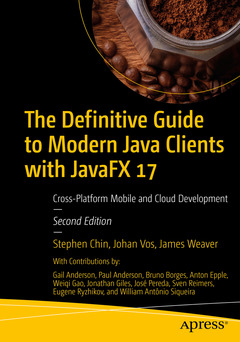Description
The Definitive Guide to Modern Java Clients with JavaFX 17 (2nd Ed., 2nd ed.)
Cross-Platform Mobile and Cloud Development
Authors: Chin Stephen, Vos Johan, Weaver James
Language: English
Subjects for The Definitive Guide to Modern Java Clients with JavaFX 17:
Keywords
Java; JavaFX; JavaFX 17; mobile; clients; user interfaces; UI; UX; user experience; oracle; programming; development; Java Champion; experts; definitive; authoritative; source; code; cloud; Java FX
68.56 €
In Print (Delivery period: 15 days).
Add to cart613 p. · 17.8x25.4 cm · Paperback
Description
/li>Contents
/li>Biography
/li>Comment
/li>
Build enhanced visual experiences and design and deploy modern, easy-to-maintain, client applications across a variety of platforms. This book will show you how these applications can take advantage of JavaFX?s latest user interface components, 3D technology, and cloud services to create immersive visualizations and allow high-value data manipulation. The Definitive Guide to Modern Java Clients with JavaFX 17 is a professional reference for building Java applications for desktop, mobile, and embedded in the Cloud age. It offers end-to-end coverage of the latest features in JavaFX 17 and Java 17.
Among the many new or updated JavaFX features covered are the FX Robot API, for simulating user interaction; customized step repeat timing for the Spinner control; Marlin FX; the ColorPicker color palette; and the GetCenter method.After reading this book, you will be equipped to upgrade legacy client applications, develop cross-platform applications inJava, and build enhanced desktop and mobile native clients.
Note: source code can be downloaded from https://github.com/Apress/definitive-guide-modern-java-clients-javafx17.
What You Will Learn:
- Create modern client applications in Java using the latest JavaFX 17 and Java 17 LTS Build enterprise clients that will enable integration with existing cloud services
- Use advanced visualization and 3D features
- Deploy on desktop, mobile, and embedded devices
Who This Book Is For:
Professional Java developers who are interested in learning the latest client Java development techniques to fill out their skills set.




